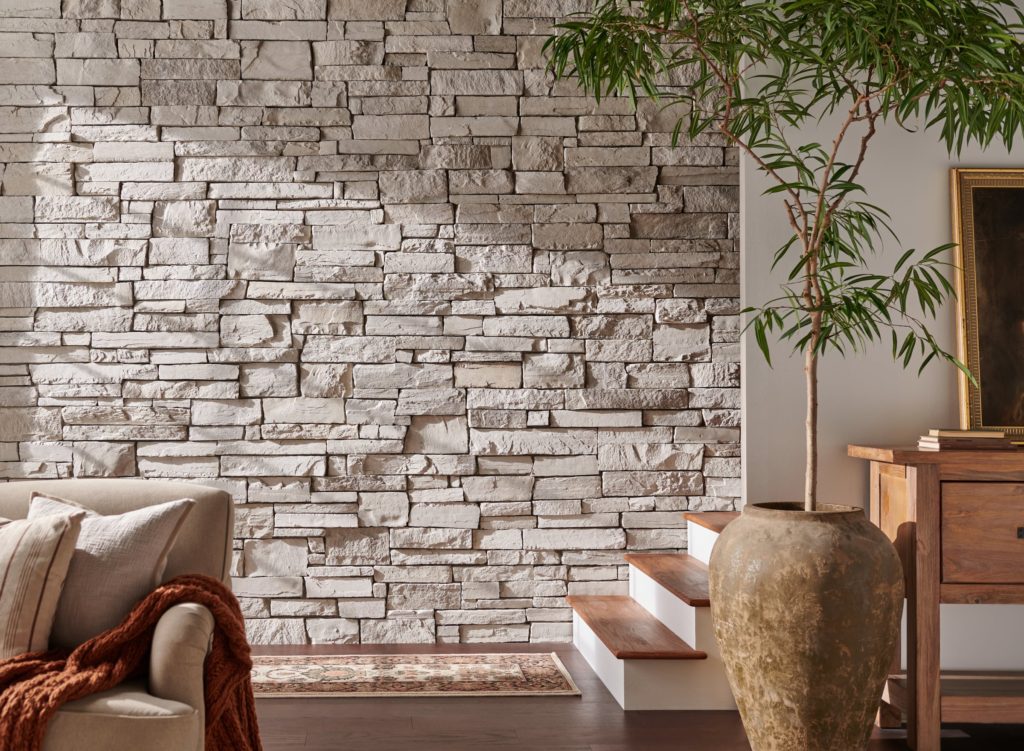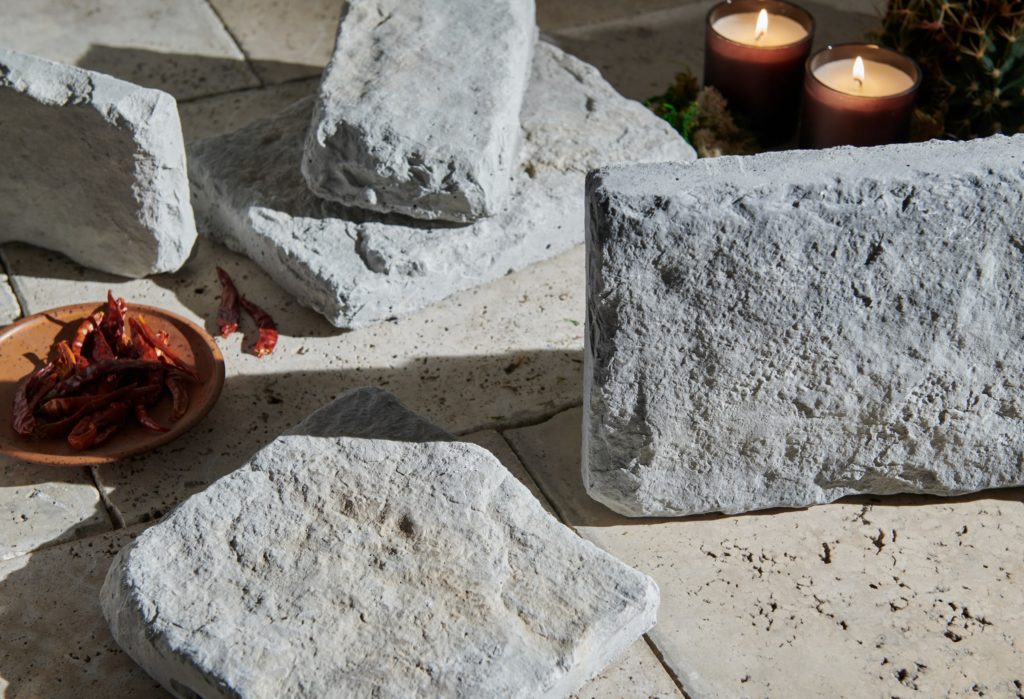Thin Is In: Key Distinctions Between Natural and Manufactured Stone Veneer
Words: Jeff Tew
Words: Jeff Tew, Director of Technical + Training, Westlake Royal Stone Solutions
Photos: Cultured Stone
Sponsored By

Over the years, the great debate within the stone industry has focused on how manufactured stone veneer (MSV) compares to natural stone. While both provide many benefits, MSV’s lightweight properties, which allow for faster installation and require fewer to no structural interventions such as footings and tie-ins, have given it a clear advantage over full-bed-depth natural stone on both commercial and residential projects. Also, unlike full bed natural stone, MSV can be applied to a variety of substrates including wall sheathing, cement board and concrete.
In contrast to full bed natural stone, thin stone veneer does not require a brick ledge or shelf angle, and your framing is pushed to the outside of the wall to allow for a sophisticated masonry look while maximizing the usable square footage inside the home. This can make a serious difference in spaces both large and small. And in almost any use case scenario, MSV will go up on the wall much more rapidly than full bed stone.
What About Thin-Cut Natural Stone?
Today, the debate has shifted with the growing prevalence of thin-cut natural stone, which offers comparable benefits in terms of weight and overall application opportunities. Now that natural stone brands offer thin-cut profile options, what differentiates natural veneer from manufactured products?
Here are three important factors to consider when weighing the alternatives:
1. MSV Offers a Growing Selection of Contemporary Forms
Manufactured stone profiles provide specifiers with a range of diverse color palettes, textures and shapes. Particularly within the past decade, manufacturers have expanded their portfolios to cater to new audiences by providing solutions beyond the strictly “natural” look and feel, which has led to developing a growing selection of linear, contemporary shapes and cuts. These large-format, plank shaped and/or panelized profiles come in a variety of saturated monochromatic hues, as well as diverse and multilayered color palettes to help blend traditional and contemporary aesthetics. The focus on design diversity extends to brick veneer options as well, with manufacturers producing a number of evocative dark and nuanced white brick profiles to appeal to contemporary design sensibilities.

Architectural stone veneer, which includes the highest quality MSV products on the market, also draws inspiration from elements outside of the stone and brick category altogether. Aged barnwood, for example, offers texture and color variations that exemplify the Modern Farmhouse design aesthetic and support the growing influence of biophilic design in both residential and commercial applications around the nation.
Some MSV providers also offer large format options that apply quickly and embody the same lightweight characteristics as smaller format products. This helps to address a growing market interest in large format wall surfaces that lean more contemporary in appearance and complement the overall architecture of a space, and most natural veneer products are limited in size and scale due to weight.
2. MSV is Packaged for Jobsite Efficiencies
Time efficiencies on the jobsite can make or break a project when it comes to staying on schedule and on budget. Even the most subtle differences in packaging technique can heavily influence the effectiveness of the project team, and this is an area where architectural stone veneer excels. As a manufactured product, architectural stone and brick veneer is carefully packaged in a pre-blended manner, with multiple shapes and color tones already arranged in a varied aesthetic. This can help masons and other workers save time over implementing thin-cut natural stone options, which tend to be packaged with little variation and therefore require more extensive unboxing, sampling and shaping of materials to blend shapes and color tones before application.
Architectural stone veneer involves stone shapes and/or panelized systems that are precision engineered to fit together with little to no cutting and shaping, and the products are thoughtfully packaged in layers to be install-ready right out of the box. This minimizes the amount of physical waste from shaping and cutting and results in less jobsite cleanup time. Most natural stone products, by comparison, will require more cutting and shaping throughout application, resulting in additional cleanup time once installation is complete.

Working with product that has already been carefully arranged during the manufacturer’s packaging process can be particularly effective when you’re working with an interior space, since it requires less of a footprint to arrange and prepare the material for application. Even when you consider something very small in scale, such as a mock panel that you create to show the client what the final application will eventually look like, the prearranged nature of architectural stone veneer products creates time efficiencies for everyone on your crew.
In terms of application benefits, one other area where manufactured profiles excel is that they feature a raked-back construction that makes for an easier application process compared to the smooth-back surface of thin-cut natural stone. Once again, this can help to accelerate your application process and make the project run more smoothly than when working with a natural veneer product.
3. MSV Offers Reliable Long-Term Color + Texture Options
Throughout the life span of the stone veneer product, manufactured profiles also prove to be incredibly reliable in offering shapes and color palettes to match existing applications when a homeowner or business decides to expand its physical footprint. As a manufactured product, architectural stone veneer offers more consistency in color application from one box to another, and this color consistency is achievable over the long term, with color palettes to match previous project applications many years down the road. Finding and/or developing an exact match with manufactured veneer can also be less time consuming in terms of both sourcing and installation when compared to thin-cut natural stone.
Color consistency can also benefit some projects in the short term. For example, large commercial projects with significant quantities of stone may find it challenging to source natural stone veneer products that provide the color consistency required for an entire building façade. Since many natural stone products are not packaged in a pre-blended fashion, it may be more difficult for workers on some larger projects to identify and adjust for color shifts while moving from one crate to the next.
On any project site, time is often at a premium and the final aesthetic of the finished wall reigns supreme in the mind of the client. This means that every decision your team makes needs to address those two factors—time and appearance—in the most effective way possible. Achieving project efficiencies with and for your team are great in the short term, and guaranteeing the long-term visual appeal of the project space will keep clients singing your praises for years to come.
While the development of thin-cut natural stone certainly yields advantages over full-bed-depth natural stone, MSV continues to provide significant advantages in terms of its contemporary offerings, pre-blended arrangement within the packaging, and long-term color and texture consistency. Among a growing selection of stone veneer options, manufactured profiles remain the preferred choice for interior and exterior spaces in a growing variety of residential and commercial projects.